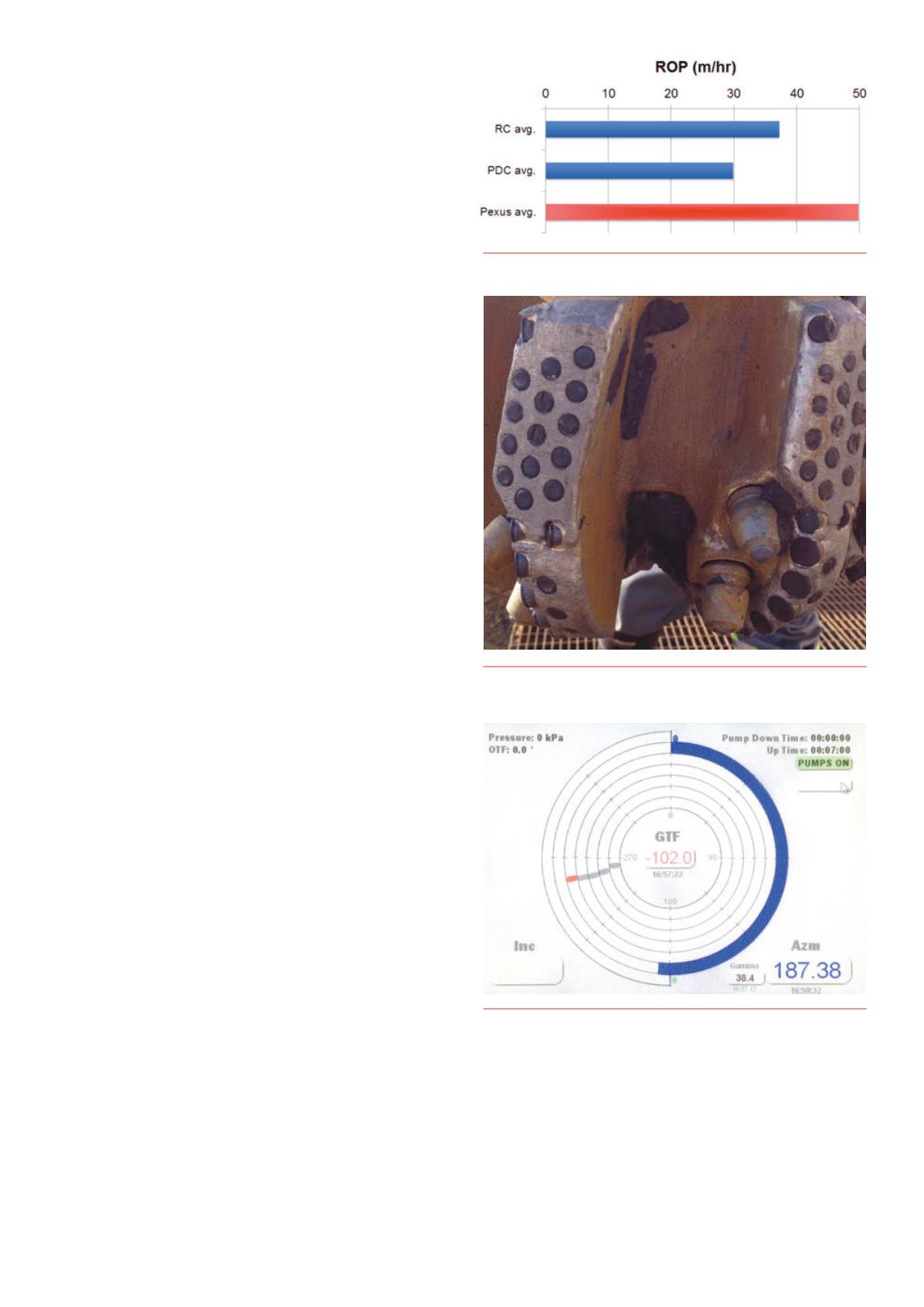
June
2015
Oilfield Technology
|
53
bits, a proprietary body construction was developed. This new
body type, called ‘composite‑bodied’, includes a high strength
steel structure and a thick tungsten carbide matrix shell. Because
the primary structure of the bit is steel, composite‑bodied bits
enjoy all the performance benefits of steel‑bodied bits. Further,
because the tungsten carbide shell contains a higher percentage of
carbide than a conventional matrix‑bodied bit, the wear resistance
of the new body construction is higher than that of matrix bits. As
seen in Figure 3, even in bits of identical cutting structure design,
the composite body far outlasts matrix bodies in comparable
applications. The pictures shown in Figure 3 are of SHEAR BITS’
Oilsands Series PDC bit designs that drilled lateral intervals in
Canadian oilsands applications. This application is well known
to be one of the most challenging in the world with regard to bit
body wear, as is exemplified by the extreme matrix loss on the
matrix‑bodied bit runs.
2
Over the last 1 ½ years, Pexus hybrid bits have proven to be
successful in drilling large diameter vertical surface intervals
throughout Western Canada.
1
However, there are many more
applications where this technology has already proven to
be of significant benefit to drilling programmes. The hybrid
gouging/shearing cutting structure has demonstrated smoother
drilling behaviour and greater resistance to impact damage than
conventional PDC bits, and also higher ROP than rollercone bits.
Therefore, in many situations where directional drillers struggle
to control PDC bits, or resort to running rollercone bits in order
to achieve the directional targets, Pexus technology can deliver
improved ROP and durability. Additionally, in applications where
the formation is either heavily interbedded or contains significant
percentages of conglomerates, chert or pyrite, Pexus technology can
enhance performance over conventional bit types.
Intermediate and production holes are commonly drilled
with either PDC or rollercone bits, both of which have their own
unique set of disadvantages. Drilling with rollercones often means
compromising on ROP and commonly requires multiple trips to
complete an interval, whereas PDC bits often lack steerability and
suffer from durability issues in highly transitional and interbedded
formations. Applying Pexus technology in these situations has
produced improved performance in hole sizes from 6 ¼ in. up to
12 ¼ in. diameter. In larger hole sizes, such as 10 ⅝ in. to 12 ¼ in.
diameter, directional programmes with relatively high build rates
can be very challenging with PDC bits due to the torque response
that comes along with shearing cutting structures. The total
torque output of any drill bit is relative to the diameter of the
bit as larger bits require more torque to drill. The fluctuations in
torque response from a PDC bit also increase in proportion to its
diameter. Therefore, larger diameter PDC bits create both more
overall torque and larger swings in torque as they drill. As a result
of this situation, as the diameter of the bit increases, the likelihood
to perform directional work with a PDC versus a rollercone bit
decreases. In other words, in larger hole sizes, it is still more
common to drill challenging directional intervals with rollercone
bits instead of PDC bits.
In order to tackle smaller diameter build and lateral intervals
more effectively, SHEAR BITS has developed a new approach to
the Pexus gouging insert layout and blade geometry to incorporate
all of the benefits of the technology in bit sizes as small as 6 ⅛ in.
(156 mm). Unlike the ‘full gouging’ layout, where there are gouging
inserts in front of every blade of PDC cutters, used in larger hole
sizes that has proven to be highly effective in applications that
contain large gravel or conglomerates, the design strategy for
smaller hole sizes only incorporates gouging inserts in selective
regions of the bit. Figure 5 shows an example of one Pexus hybrid
design for lateral production intervals. The 6 ¼ in. (159 mm)
SHP613D has gouging inserts mounted only in front of the three
secondary blades of the bit, and includes six nozzles to effectively
dedicate hydraulic energy to every blade of PDC cutters. This layout
improves cooling and cleaning around all of the PDC cutters to
increase cutter life and ROP, while still providing the durability and
behavioural benefits of the gouging cutting mechanism.
Figure 6.
ROP comparison in 12¼ in. oilsands build interval.
Figure 7.
Dull condition of a 12¼ in. Pexus hybridbit after completinga
challenging S curve interval.
Figure 8.
Photo of toolface plot takenduringa slide in the 6¼ in. SHP613D
run.


